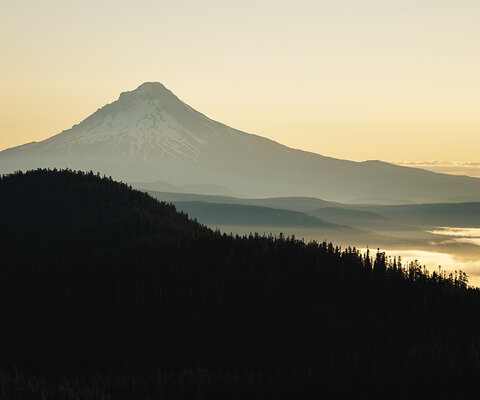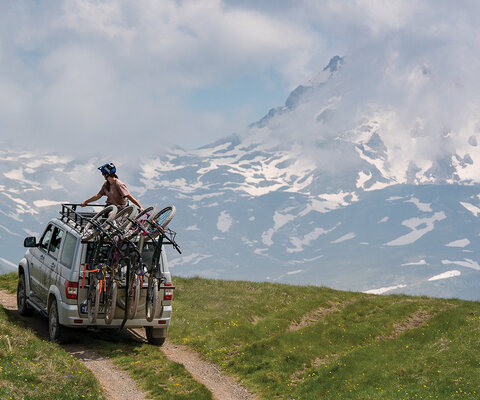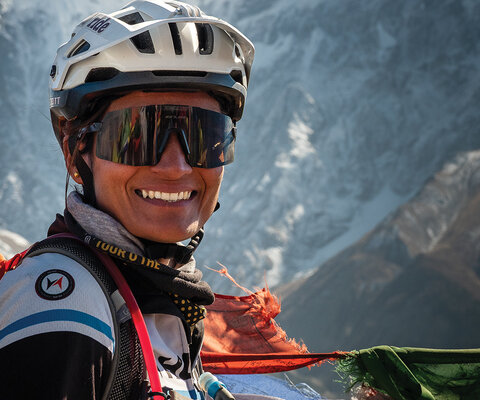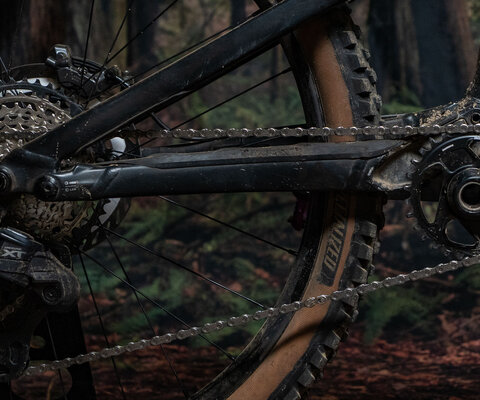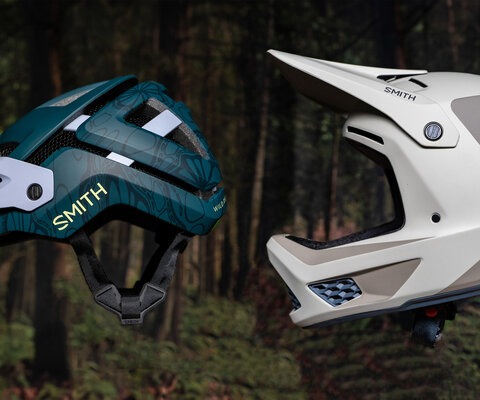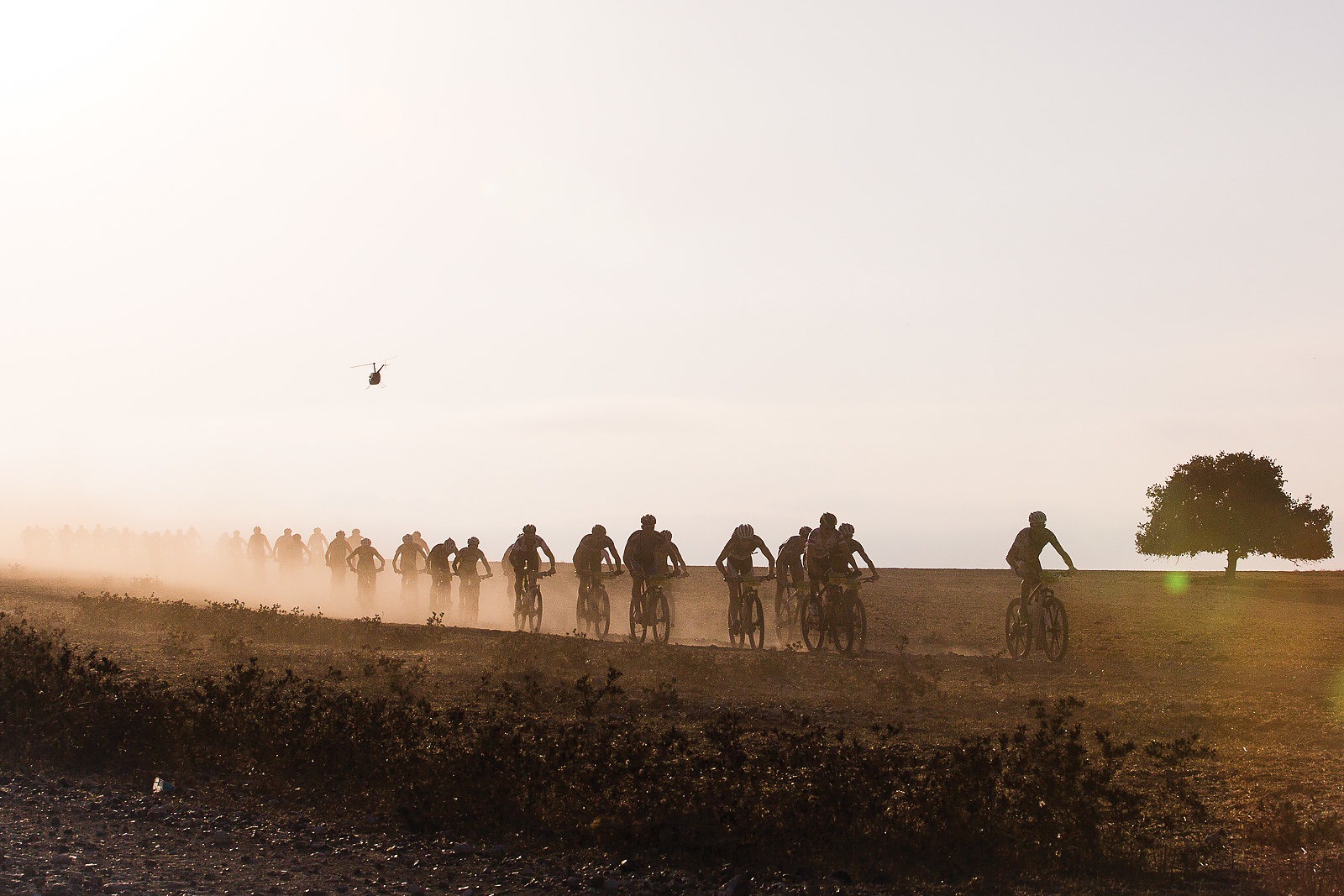
Echoes of Abraham - Pain and Pilgrimage in Jerusalem
I ponder the email, blinking at me from my inbox like some golden ticket from Willy Wonka’s Chocolate Factory.
This ticket’s destination, however, isn’t some confectionary wonderland. It is an invite to a three-day stage race in Israel, the heart of the Middle East. My subconscious accepts the invitation immediately. My higher brain hesitates.
Leaving the computer I turn on the news, and headlines about airport closures, bombings and cross border tensions stream across the screen. For someone unfamiliar with the area’s political workings, it does not seem to be a prime place for tourism, much less a mountain bike race. Yet that’s what the email says.
The opportunity to make my own pilgrimage to the Holy Land is already tamping down my doubts. Add 172 miles of pedaling and 17,761 feet of climbing through the pages of the Old and New Testament, the Torah and the Quran, and I begin to forget the guns and rockets.
In its second year, the KIA Epic Israel takes many of its cues from South Africa’s Absa Cape Epic, including the two-rider team format. Before I can make my decision I need a partner, and I call up my longtime race buddy and photographer Chris Christie. Chris has shot action sports all over the world and gets places that most photographers never do, be it in the mountains or inside the peloton.
My hesitation continues, but no real reason to back out presents itself: traveling to Israel requires no visas for Canadians, the tourism department is graciously accommodating, and my family just blinks and says, “Of course you should go!”
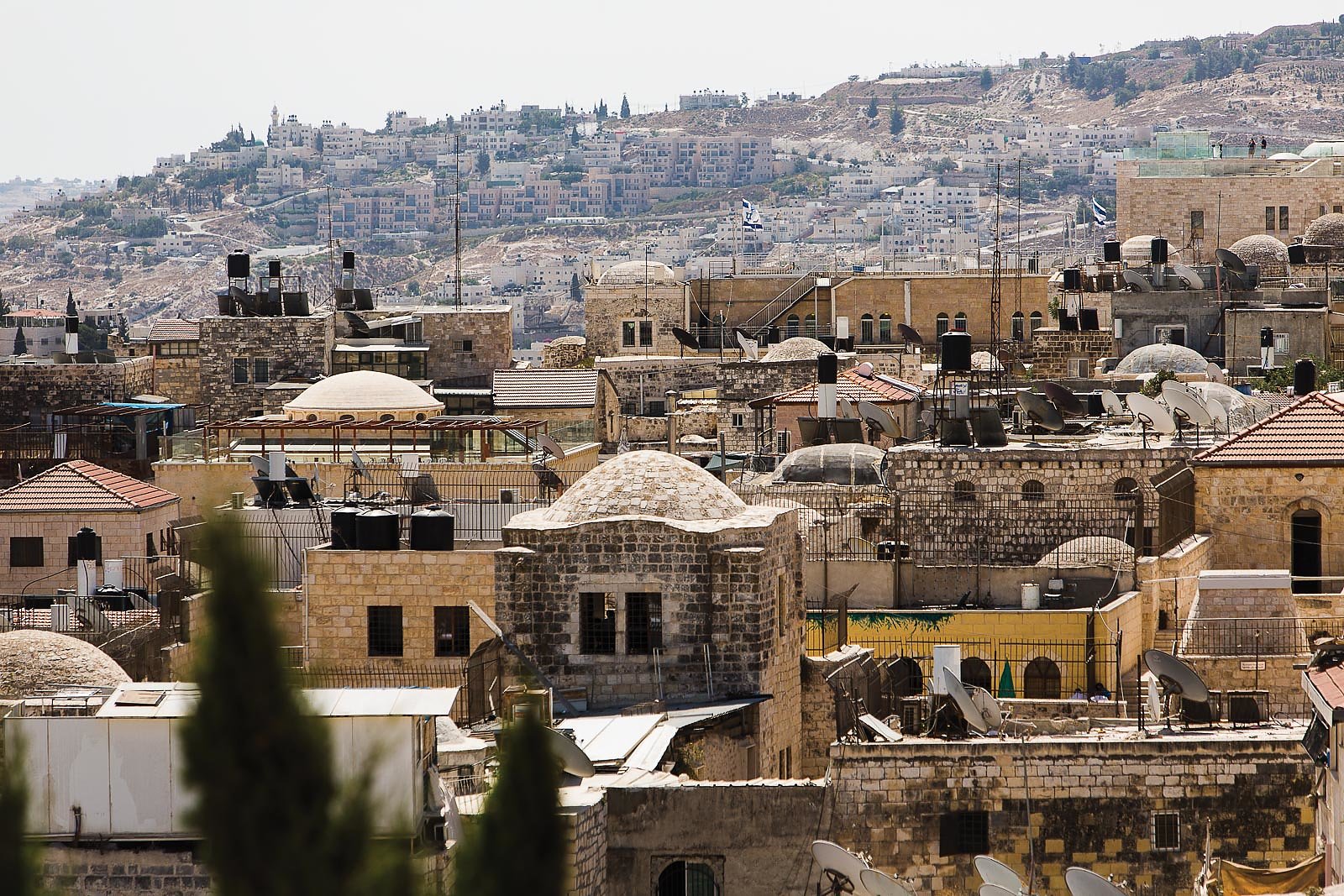
With all my excuses exhausted, a few weeks later Chris and I are standing at the terminal of the Vancouver International Airport heading towards the Middle East—rockets, religions, stage races and all.
Brown agricultural fields stretch below us as we glide into Tel Aviv, descending towards the Ben Gurion International Airport. I’m holding my breath, assuming this is where a surface to air missile will strike and turn us into a ball of flame. Apparently I’m not the only one with such worries—the cabin is silent as we approach the runway, and the spell is broken by a polite golf applause after we land and sidle towards the terminal.
Ben Gurion handles over 13 million travelers a year, and so I should not be surprised when we exit into a completely modern building. A tourism official, holding a sign “Hestler and Christie,” welcomes us with a broad smile. As simple as that we’re in the Holy Land.
The Epic Israel starts on the 15th of September, but we’ve planned two days to explore the living museum that is Jerusalem. It is a 45 mile drive from Tel Aviv to the city, climbing into the foothills of the Judean Mountains to nearly 2,500 feet above sea level. The surrounding pink desert and small valleys are covered in terraced olive groves and ancient aqueducts, occasionally punctuated by man-made forests.
It’s a landscape that attests to a long history of dry heat and limited water, and while technically the start of autumn, September highs in Jerusalem still average the low 80s Fahrenheit. Our forecast for the week is supposed to be cooling—which means the highs will reach just under 95.
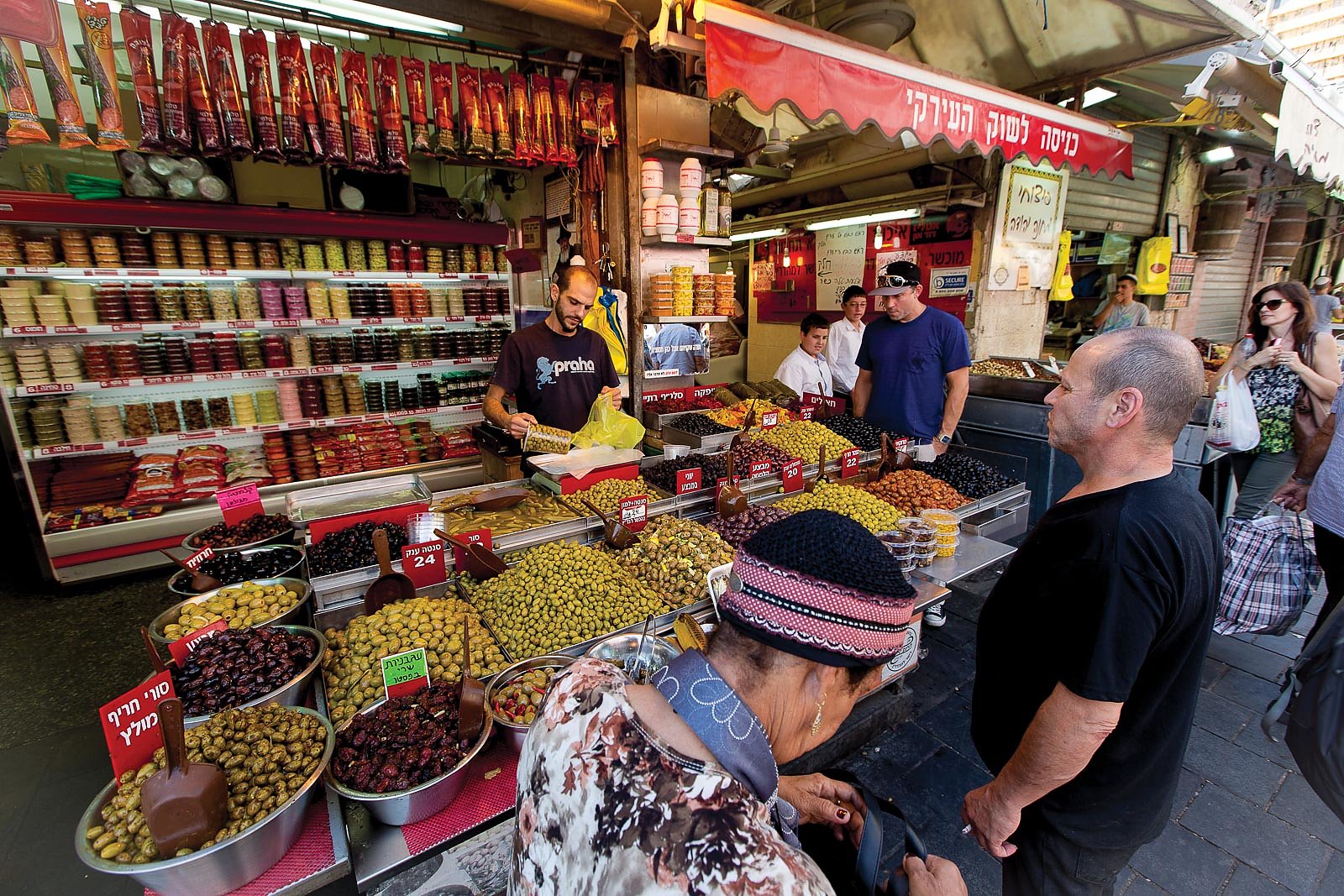
Jerusalem has grown significantly since the state of Israel was created in 1948. Its population is now nearly 800,000, an eclectic and peaceful mix of Jewish, Muslim and Christian citizens. While it’s a stable situation these days, it hasn’t always been so: all three consider Jerusalem a holy site and all three have waged war to call the city theirs. It’s been attacked some 75 times, successfully conquered nearly 50 times, and destroyed twice—hence the ancient defensive walls surrounding parts of the city.
For us, however, the only signs of modern military presence we see are concrete walls and barbed wire along the highway, and the checkpoint we pass through seems more toll booth than military post. Jerusalem itself feels like a European city, obviously old but orderly and first-world. We step from the cab, ready to explore a place we had previously only experienced through the news, Christmas carols and Bible verses.
As it contains the most sacred sites for all three Abrahamic religions—Judaism, Christianity and Islam—Jerusalem is often considered the holiest city in the world. One simply has to turn a random corner to visit a hallowed building or temple, and the first one our guide Mitch leads us to is the Church of the Visitation.
Dedicated to Jesus Christ’s mother meeting John the Baptist’s, Mitch explains how the Church was built over the town’s central well, always the hub of settlements in the desert. The building itself is a soaring mix of Italian architecture, frescoes and Byzantine tile work, and compared to the modernity of the nearby Israel Museum it looks medieval.
It is the museum, however, that houses something truly ancient: the Dead Sea Scrolls, the oldest biblical manuscripts in the world, and as we walk through the displays Mitch tells us about their discovery and religious significance. The history lesson continues as we return to our hotel, and he continues to inundate us with dates, places and historical references. It’s almost too much for our jet-lagged minds to absorb.
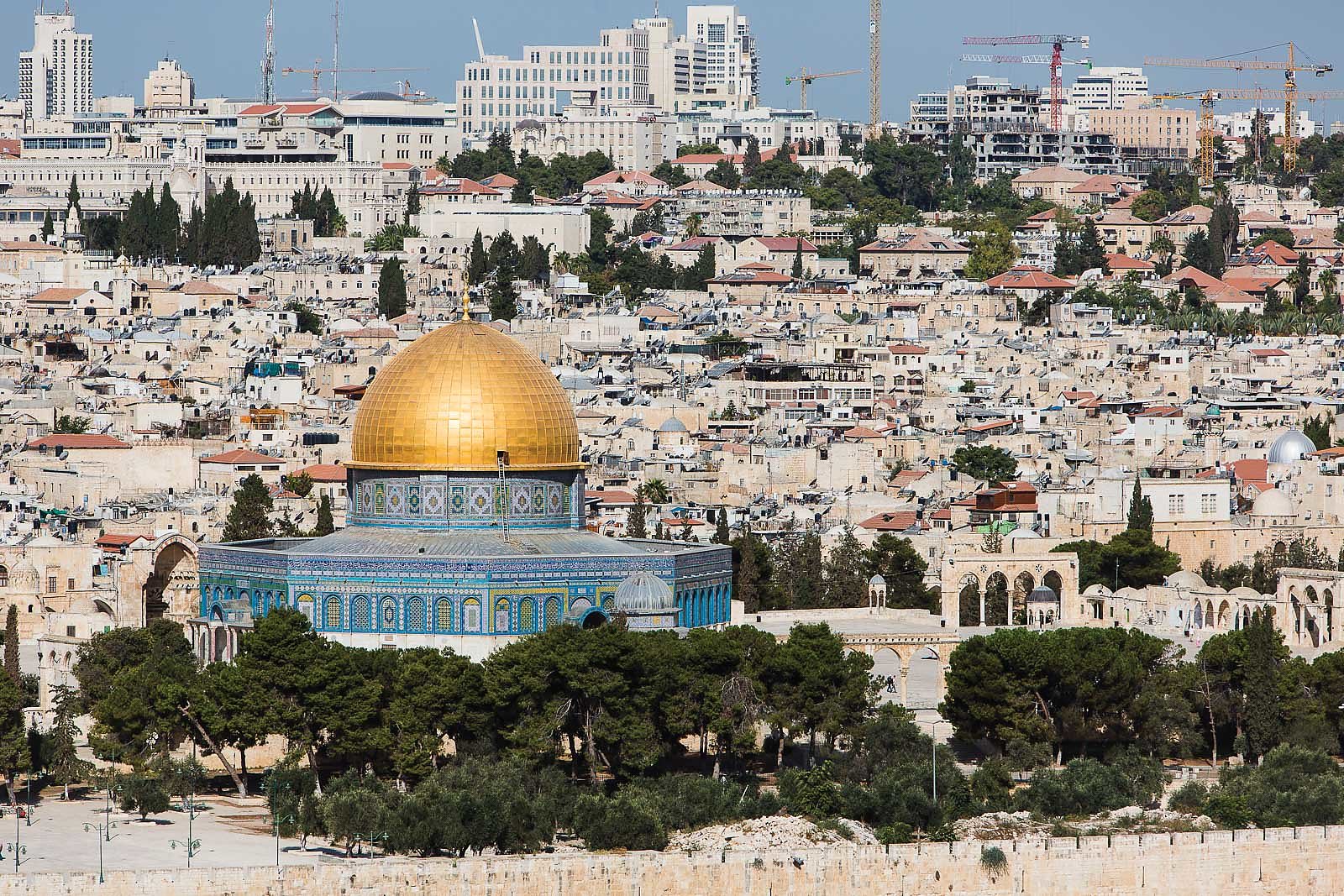
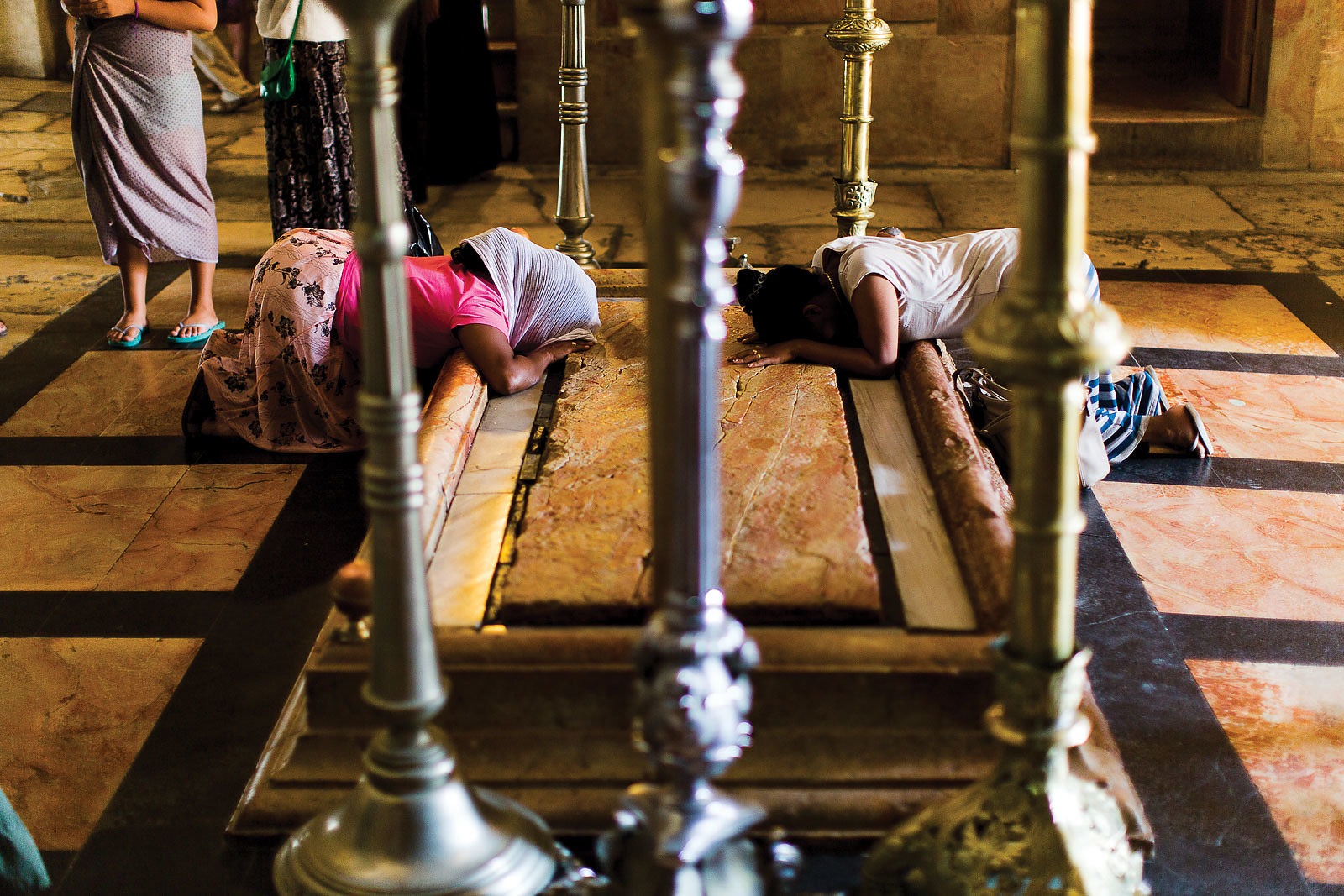
We spend our second morning on the Mount of Olives. In front of us the walls of Old Jerusalem separate it from the newer parts of the city, and a golden dome dominates the minarets, spires and church steeples contained within. This is the Dome of the Rock, which, according to some Jews, is the spiritual junction between Heaven and Earth. It is the most sacred spot in Judaism and easily the most recognizable in the city.
As we walk back to town we pass thousands of graves; the Mount has been used as Jewish burial site for over 3,000 years and houses some 150,000 graves, including many of the Bible’s significant figures. The most sacred of locations, however, are all located behind those pinks walls of Old Jerusalem. The “Old City” is home to some 37,000 people and is divided into four parts: the Jewish Quarter, Muslim Quarter, Christian Quarter and the Armenian Quarter, all representing different cultures that have held the city.
One of the most famous of these sites is the West or “Wailing” Wall, the sole remains of the second Jewish Temple. The crevices between the 3,000-year-old stones are packed with prayer notes put there by generations of pilgrims, including the traditionally dressed Haisidic Jews praying in front of us. According to Judaism, the Wall contains the second temple’s divine presence, and as the Middle Eastern sun burns down on our heads we offer our own respects.
The narrow, twisting road we take from the Wailing Wall, called the Via Delarosa or “Way of Suffering,” is also considered holy: the route’s 2,000 feet are regarded as the path Jesus walked to his crucifixion. It is not, however, as revered as the castle-like structure at the end of the Via Delarosa.
Having suffered multiple renovations, modifications and even having once been destroyed completely, the Church of the Holy Sepulcher is the most sacred spot in the Christian faith. It is said to cover both Golgotha, the place where Jesus was crucified, and his tomb, where he was buried and is said to have risen from the dead. Millions of pilgrims and tourists visit the Church each year, and I am awestruck by both the crowds and the heady emotions of the faithful that surround us. I can’t help but contemplate my own passions, the deep yearning for the outdoors and zeal for two-wheeled adventure. Is it an irreverent thought to have in this place, or a sign of my own personal religion?
It’s a question I can’t answer, but as we move on I am left to continue my musings. In a place so revered by so many people, it’s impossible not to.
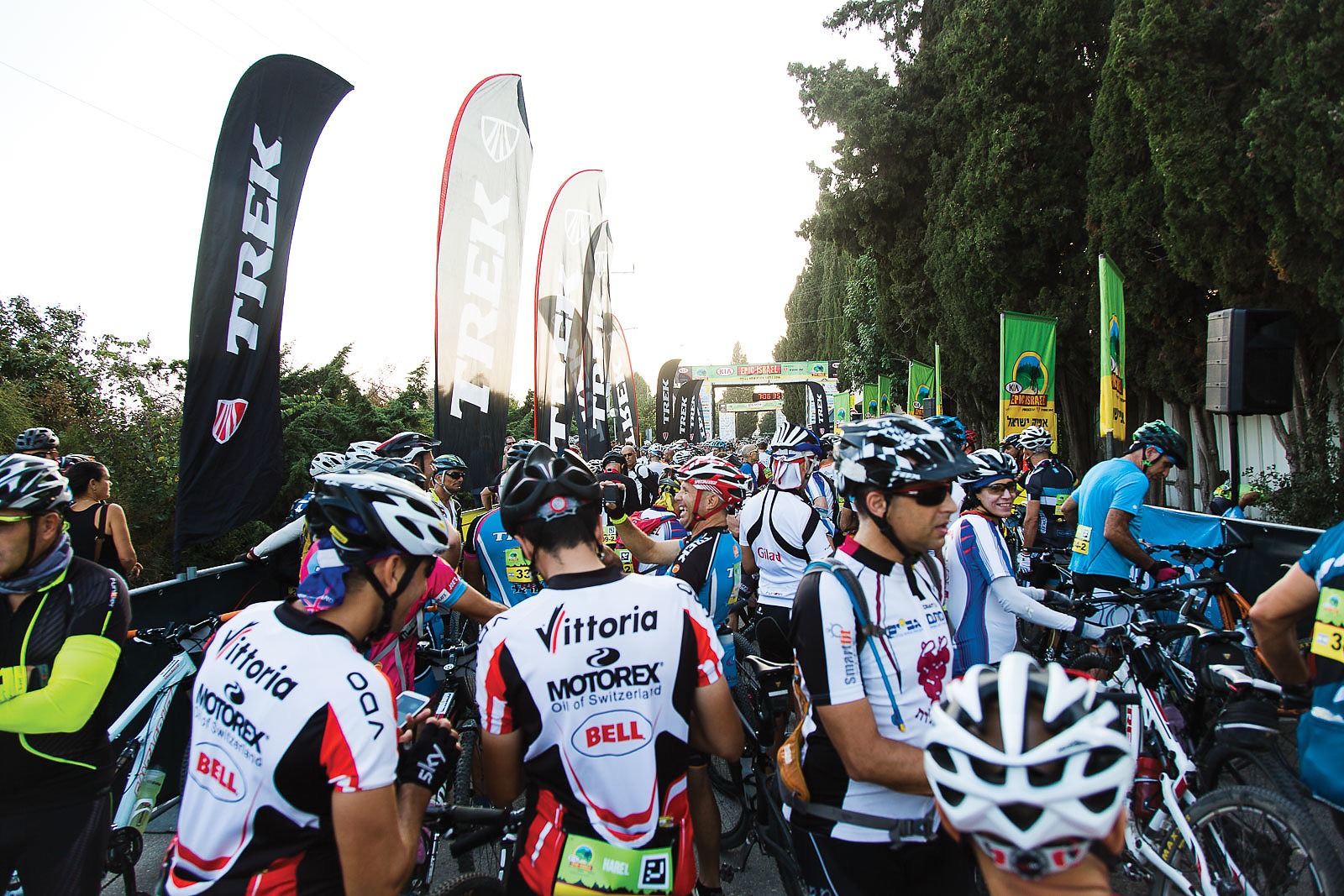
The race is set to begin the following day, so we are shuttled north a few hours to Kibbutz Dahlia, our home for the next three nights. Historically, a kibbutz is a sort of commune, a collective community generally organized around agriculture. In more modern times, many kibbutz have delved into other industries—and capitalism, as many of those industries are now privatized.
Economic preference aside, registration for the Epic Israel is flawless and easy, and the kibbutz’s small community welcomes us with open arms. The majority of the 500 racers are Israeli, but some Spaniards and six other international journalists share our accommodations.
The next morning our alarm rings at 6 a.m. to the sounds and smells of breakfast, and despite the early hour outside temperatures are already rising. We have 56 miles and almost 5,000 feet of climbing ahead. Chris and I take a mid-pack position and plan to ease into Stage 1.
The gun goes off promptly at 7:30, and we amble out through a cloud of dust into the rolling countryside and alongside farmers’ fields. While there is room to pass, the jagged rocks make staying on course paramount, and many racers are quickly sidelined with flats as the miles fall beneath our wheels. Staying on route, we decide, is the goal of the day.
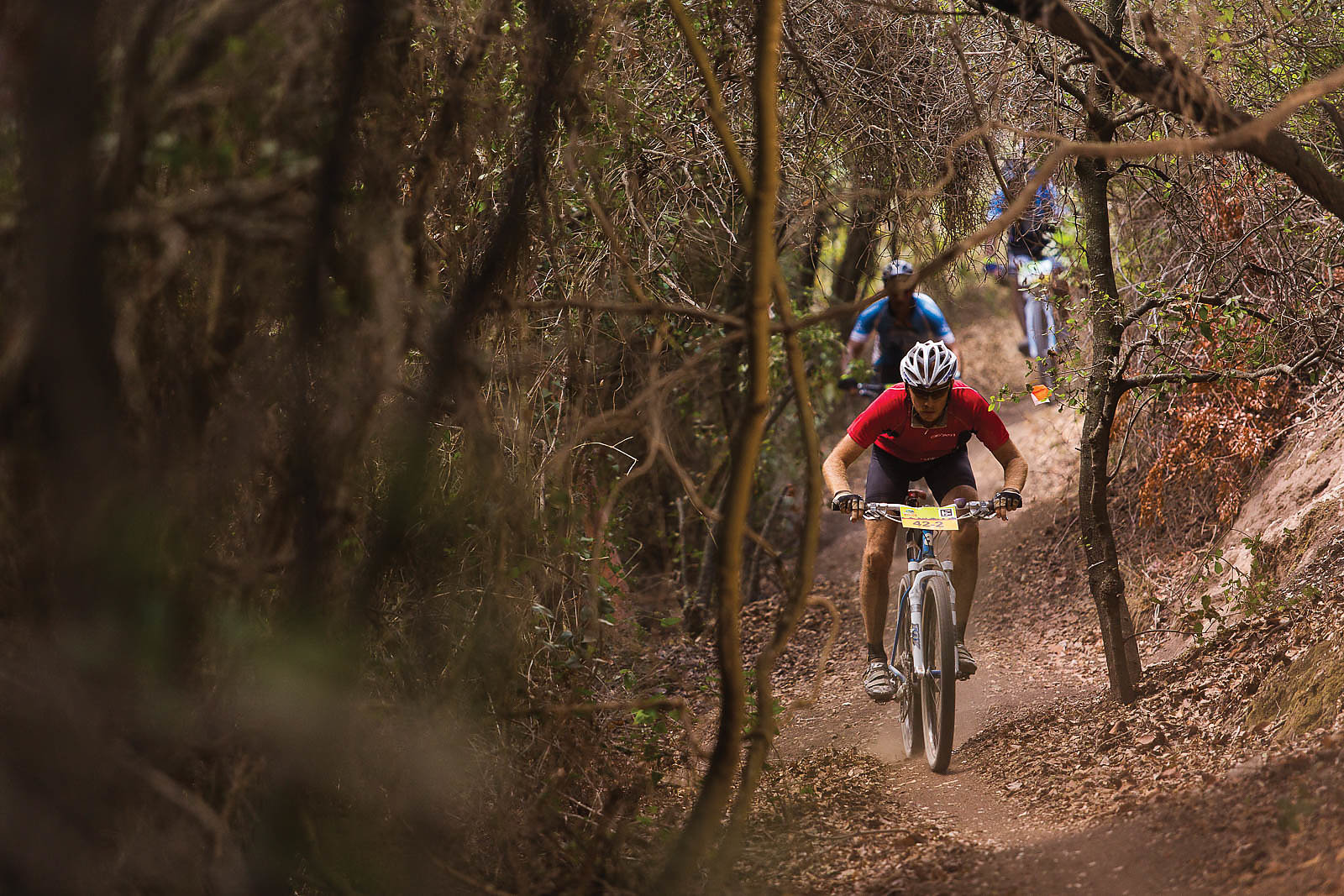
The course winds in and out of olive groves, their sparse shade providing no respite from the increasingly brutal sun. I quickly drain my water bottle, and it doesn’t take long until I’m a mushy ball of useless Lycra. The dust clings to my sweat-covered body and becomes a layer of viscous mud. “Easing” into the first stage is quickly abandoned in favor of survival.
Salvation comes in the form of a gas station two-thirds of the way in. We stop and creakily dismount, thoughts of cold cans of Coke in mind. Luckily, this isn’t my first race abroad and I’m packing some shekels, the Israeli dollar. We each grab a can of sugary carbonation and plant our grimy, grateful asses on the curb.
The break does us well, and soon we are chatting with other gas station denizens who ogle our outfits and mashed demeanor. Recharged by the sugar and rest, we set off again, enjoying the landscape on our way to the finish line. After the race, Chris pulls up the photos from the day—images of me in agony, dragging my dirt-covered carcass across a strange, desert landscape. And that’s only the first stage. Despite my second-place finish in the Enduro segment, I’m not positive I’ll be able to finish the next. Still, we have an entire night to recuperate, and we didn’t fly nearly 8,500 miles not to try.
Stage 2 begins an hour earlier—a good thing, as it allows more time in the cool(ish) morning air and less in the torturous midday heat. Today is the “queen” stage, with nearly 60 miles and over 6,500 feet of elevation gain, and so every second out of the direct sun is vital.
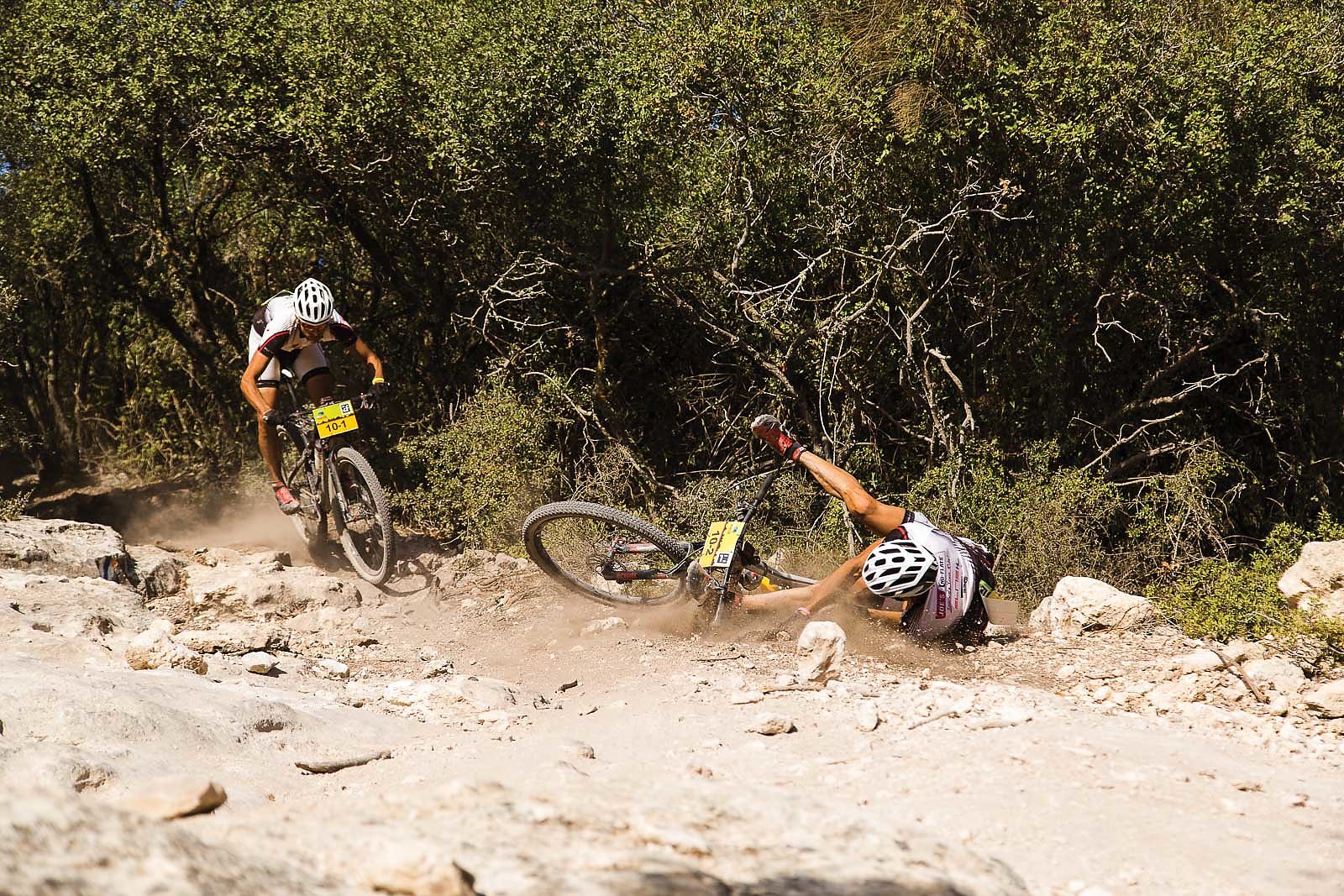
Despite the previous day’s doubts, I am feeling a little better as we start the first climb, jostling and joking with the locals. Chris and I have a much lighter approach than the competitors around us, and eventually cajole some smiles and comments from our trail mates. For them, this is an important race. For us, the importance is being halfway around the globe, riding our bikes through some of the world’s most hallowed land.
The heat arrives at 10:30 a.m. I wilt significantly, once again slogging on overheated legs until we pull into view of the Mediterranean Sea, far off in the distance but still a welcome sight. A cool wind accompanies the view and lifts our spirits, and we find some drive to soldier on, enjoying the countryside and laying claim to another second place in the Enduro. The evening award ceremony is a little less painful, and our energy slowly returns. Misery is more bearable when you know what to expect.
There are few things that draw people together as quickly as suffering, and so between the time on the track and in the mess halls we soon get to know our fellow competitors. With two days down and only one to go, the banter takes on an organic cadence and we are honored with a glimpse into the heart of Israeli mountain bike culture. This is what racing is all about, and it gives us some much needed hope and ambition. While the worst may be behind us, there are still 58 scorching miles and nearly 5,000 feet of climbing ahead.
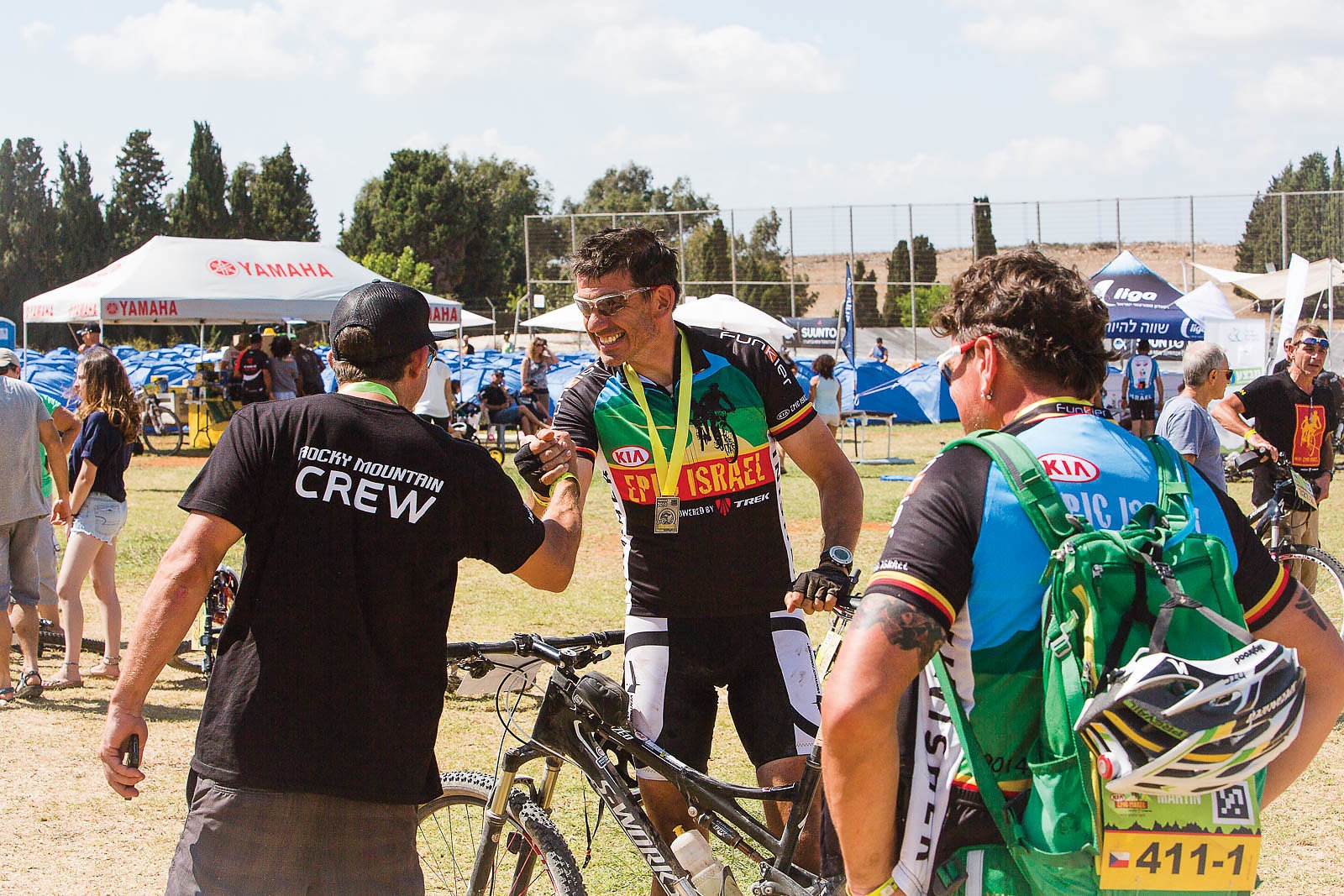
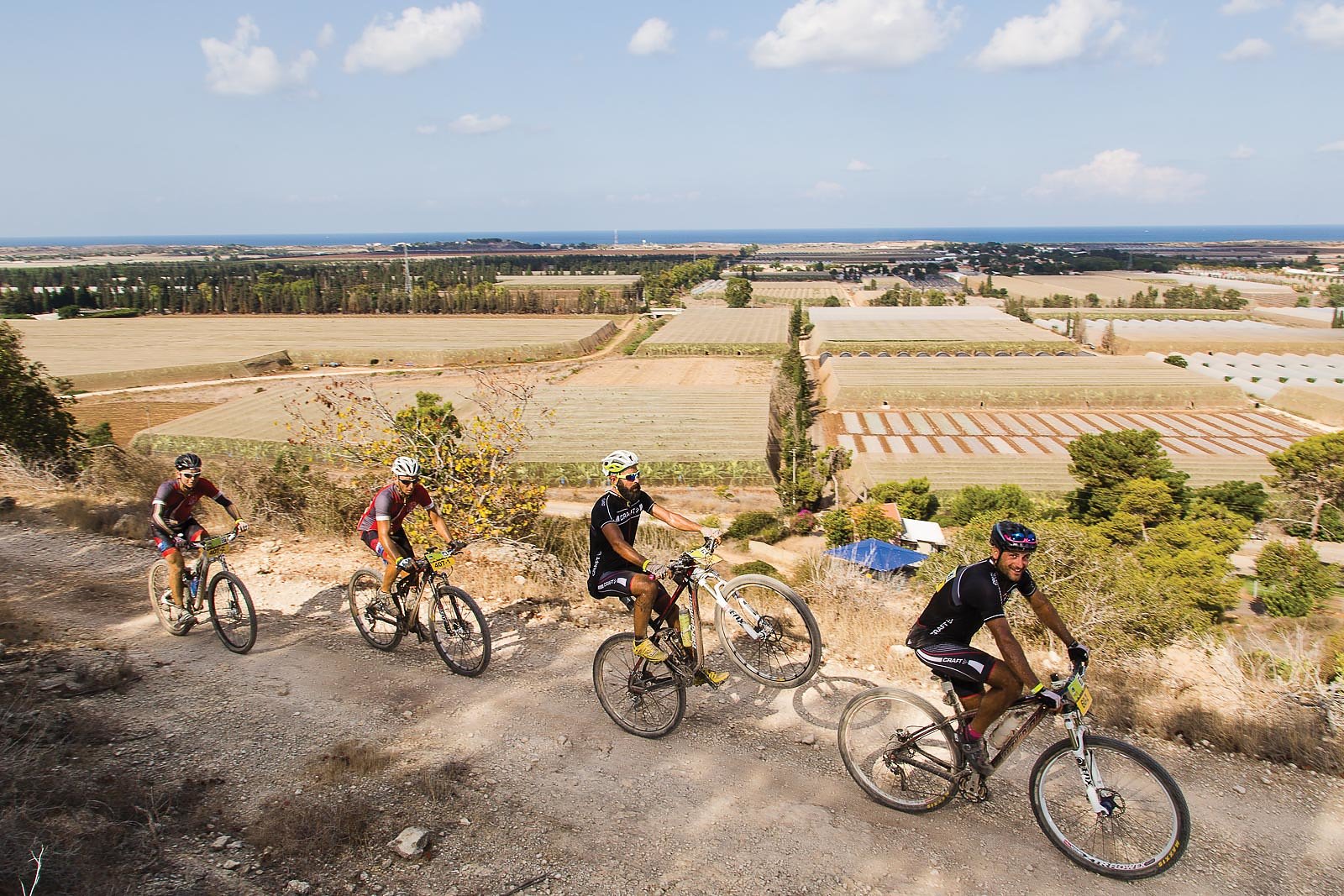
As seems appropriate for the final day, Stage 3 contains more singletrack than any of the previous legs. The first loop is spectacular, with amazing panoramas, sustained trail segments and high-speed gravel road bombing. We dash through farmers’ fields, dodging from one shaded corner to the next as we madly try to gain precious seconds before the heat fully arrives—which it does just as we climb onto an exposed, lava-esque basalt field. Aid stations break the course every 15-or-so miles, like oases in the scorching sun. Still, we are beginning to adapt to the conditions and find some “race” in our now-veteran bodies.
The last climb crosses exposed, blinding-white limestone, and while the energy to fully charge the rest of the course isn’t quite there I’m happy just to finish. We pump high fives with some of the other racers as we cross the line—it’s been three six-hour days, climbing a total of 17,760 feet over nearly 175 miles, and that’s fully worth celebrating.
It’s also fully deserving of lots of rest, and so that afternoon we head back to Tel Aviv for some recuperation. The race may be done, but we have another two days of riding planned: pedaling through the ancient port of Jaffa, and a final ride from Jerusalem through the Judean desert to the Dead Sea.
Compared to the wizened antiquity of Jerusalem, Tel Aviv is a flashy, ambitious teenager. Like most places in Israel, it can claim millennia of invaders, conquerors and pilgrims—Jaffa, in the southern end of Tel Aviv, was one of the main points of arrival for the Crusaders. That history, however, is overwhelmed by the high-rises, skyscrapers and massive beachfront hotels. As it is now home to almost a half-million citizens and is Israel’s economic and tech hub, it has reason to be boastful.

We amble about the old port and through the new city, eventually succumbing to our exhaustion on a beach with a swim in the Mediterranean. We watch surfers ply their trade, beyond the shores where Crusaders once arrived by the shipload.
One more day, one more ride, and we’re up early to meet our shuttle driver for the trip to Quiran, a small town just east of Jerusalem. From there, our guide Yoram Hen will lead us along an ancient pathway call the “Sugar Trail,” once the main trade route from Jericho, 1,200 feet below sea level, to Jerusalem.
Our group consists of some local riders as well as a few Epic Israel racers, and begins with a climb up a hill simply nicknamed “Hell.” Along the route we pass a few shanty camps belonging to an indigenous people called the Bedouins. Bedouins are true nomads, living mainly off of the land and the goats and camels they shepherd around these hills. In the 104-degree heat, it seems like a brutal lifestyle—however, it’s one they have been living for thousands of years.
From the top we’re greeted with a view of the Dead Sea, at 1,400 feet below sea level the lowest point on Earth and one of its saltiest bodies of water. Due to the high salinity, floating is a much better—and more efficient—option than swimming. Other than the miles of bitter water, there isn’t a tree or shrub in sight, just wind-scoured hills and dusty ravines.
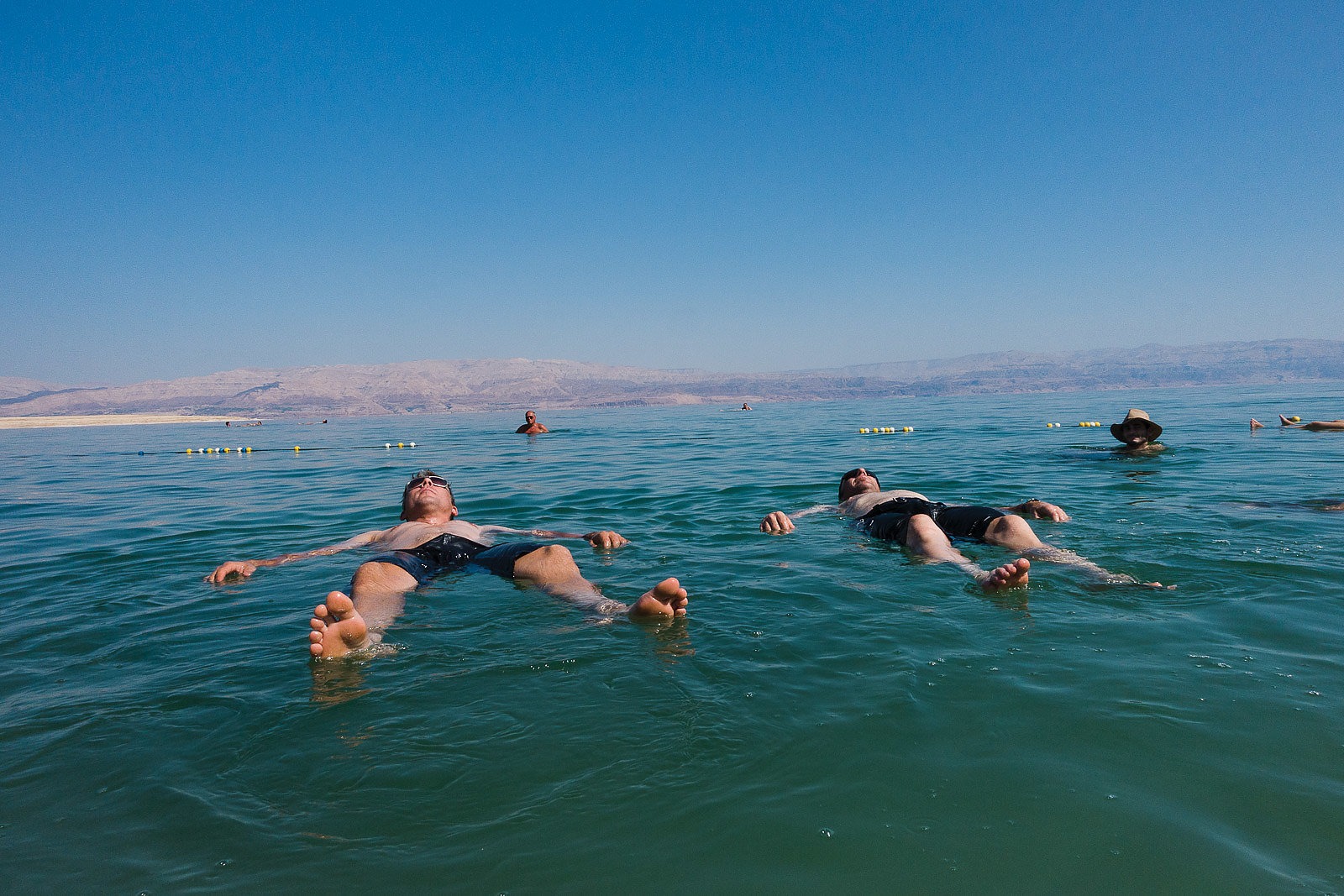
Yoram leads us over rocky crags and along flowing singletrack, passing camels, ancient cisterns and brightly colored Bedouins on donkeys, like swaying mirages in the distance. Afterwards we soak our tired legs in the Dead Sea, before making our way back to Tel Aviv, the airport and, after seven amazing days, eventually home.
Getting through security and onto the plane at Ben Gurion International is as easy as arriving, and as the wheels leave the tarmac I have only residual doubts about missiles and flaming wreckages. It’s a 14-hour flight to Toronto and another five to Vancouver, plenty of time for a few in-flight movies and a lot of thinking. My mind wanders along the hundreds of miles and seemingly thousands of years we have just ridden through, and eventually back to my musings in the Church of the Holy Sepulcher. My dirt-fueled passion may not be an official religion, but it is definitely close: we have our own rituals and temples, churches and saints, zealots and crusaders. And maybe in a thousand years, I decide, our two-wheeled disciples might make their own pilgrimages to the world’s holiest land.
Trip Information
KIA Epic Israel
www.epicisrael.org.il/en
Samar Desert Adventure – Yaron Deri / Guide
www.samardesertadventure.com
Yoram Hen Guide
www.yoramhen.co.il
